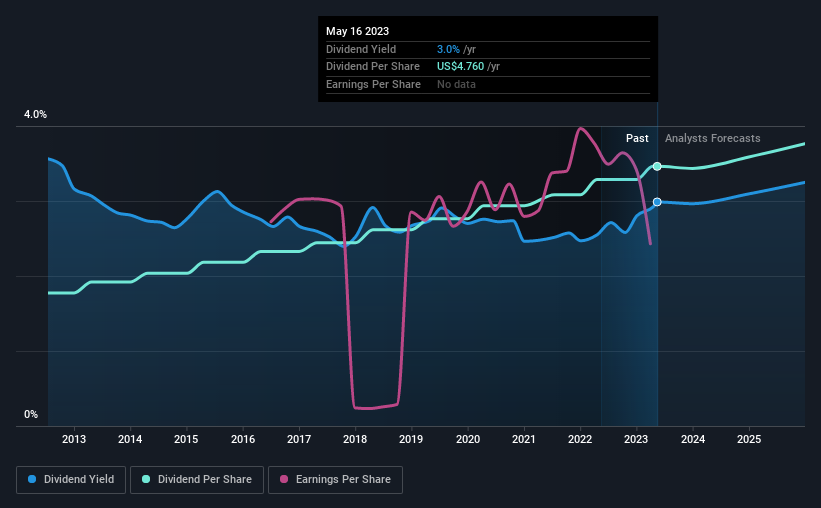Should Income Investors Look At Johnson & Johnson (NYSE:JNJ) Before Its Ex-Dividend?
Regular readers will know that we love our dividends at Simply Wall St, which is why it's exciting to see Johnson & Johnson (NYSE:JNJ) is about to trade ex-dividend in the next four days. The ex-dividend date occurs one day before the record date which is the day on which shareholders need to be on the company's books in order to receive a dividend. The ex-dividend date is of consequence because whenever a stock is bought or sold, the trade takes at least two business day to settle. Thus, you can purchase Johnson & Johnson's shares before the 22nd of May in order to receive the dividend, which the company will pay on the 6th of June.
The company's upcoming dividend is US$1.19 a share, following on from the last 12 months, when the company distributed a total of US$4.76 per share to shareholders. Calculating the last year's worth of payments shows that Johnson & Johnson has a trailing yield of 3.0% on the current share price of $159.34. If you buy this business for its dividend, you should have an idea of whether Johnson & Johnson's dividend is reliable and sustainable. So we need to investigate whether Johnson & Johnson can afford its dividend, and if the dividend could grow.
See our latest analysis for Johnson & Johnson
If a company pays out more in dividends than it earned, then the dividend might become unsustainable - hardly an ideal situation. Last year, Johnson & Johnson paid out 93% of its income as dividends, which is above a level that we're comfortable with, especially if the company needs to reinvest in its business. Yet cash flow is typically more important than profit for assessing dividend sustainability, so we should always check if the company generated enough cash to afford its dividend. Over the last year it paid out 73% of its free cash flow as dividends, within the usual range for most companies.
It's good to see that while Johnson & Johnson's dividends were not well covered by profits, at least they are affordable from a cash perspective. Still, if the company continues paying out such a high percentage of its profits, the dividend could be at risk if business turns sour.
Click here to see the company's payout ratio, plus analyst estimates of its future dividends.
Have Earnings And Dividends Been Growing?
Companies with consistently growing earnings per share generally make the best dividend stocks, as they usually find it easier to grow dividends per share. Investors love dividends, so if earnings fall and the dividend is reduced, expect a stock to be sold off heavily at the same time. It's encouraging to see Johnson & Johnson has grown its earnings rapidly, up 57% a year for the past five years.
Another key way to measure a company's dividend prospects is by measuring its historical rate of dividend growth. Johnson & Johnson has delivered an average of 6.9% per year annual increase in its dividend, based on the past 10 years of dividend payments. We're glad to see dividends rising alongside earnings over a number of years, which may be a sign the company intends to share the growth with shareholders.
Final Takeaway
Has Johnson & Johnson got what it takes to maintain its dividend payments? Johnson & Johnson has been growing its earnings per share nicely, although judging by the difference between its profit and cashflow payout ratios, the company might have reported some write-offs over the last year. All things considered, we are not particularly enthused about Johnson & Johnson from a dividend perspective.
If you're not too concerned about Johnson & Johnson's ability to pay dividends, you should still be mindful of some of the other risks that this business faces. For example - Johnson & Johnson has 5 warning signs we think you should be aware of.
If you're in the market for strong dividend payers, we recommend checking our selection of top dividend stocks.
Have feedback on this article? Concerned about the content? Get in touch with us directly. Alternatively, email editorial-team (at) simplywallst.com.
This article by Simply Wall St is general in nature. We provide commentary based on historical data and analyst forecasts only using an unbiased methodology and our articles are not intended to be financial advice. It does not constitute a recommendation to buy or sell any stock, and does not take account of your objectives, or your financial situation. We aim to bring you long-term focused analysis driven by fundamental data. Note that our analysis may not factor in the latest price-sensitive company announcements or qualitative material. Simply Wall St has no position in any stocks mentioned.
Join A Paid User Research Session
You’ll receive a US$30 Amazon Gift card for 1 hour of your time while helping us build better investing tools for the individual investors like yourself. Sign up here

 Yahoo Finance
Yahoo Finance 
